Lesser-Known Facts about Salt Lake Temple’s Construction Illustrate Pioneers’ Commitment, Sacrifice
Contributed By Aubrey Eyre, Church News staff writer

Saints gather in April 1892 to watch the placement of the capstone on the Salt Lake Temple. Photo courtesy of Charles R. Savage, Utah Historical Society.
Article Highlights
- The wall around Temple Square tested the commitment of the Saints to building the temple.
- The temple has undergone constant change from the time it was first conceptualized.
- Brigham Young received inspiration for the plans of the temple, from the materials used to the people called to build.
“[The Salt Lake Temple] is a symbol of the Saints’ sacrifice and their work and dedication of 40 years to build the house of the Lord.” —Keith Erekson, Church History Library director
Related Links
Gathered around a simple, rather barren plot of land in a vast desert valley marked by just five years of habitation, a small group of people, shovels in hand, broke ground on February 14, 1853, on what would prove to be a building project of more than 40 years. Among the turning of shovels and prayers to dedicate the land for the purposes of the Lord, the crowd began to sing an old familiar tune.
“We two have run about the slopes, / and picked the daisies fine; / But we’ve wandered many a weary foot, / since auld lang syne.”
Though the old Scottish tune is rarely associated with the early pioneers of The Church of Jesus Christ of Latter-day Saints, or even considered a religious tune, Church historian and curator of Church history sites Jacob Olmstead said the tune served as a commentary on the fact that the early Saints were beginning a new era in Church history.
“I think it’s truly a remarkable story, and you never hear it,” Olmstead said in a recent interview with the Church News. “They saw this time, this commencement on this temple, as a new era . . . forgetting the old and moving forward with the new.”
Having left behind two temples in Nauvoo and Kirtland as they were forced west, the early Church pioneers were really nothing more than a “ragtag” and destitute people living out of wagons with no money or resources when they first arrived in the Salt Lake Valley, Olmstead explained. But for the early Saints, the temple was central to everything, and, if the temple they built is any indication, that commitment never wavered.
And while the Salt Lake Temple was central for the pioneers, Keith Erekson, director of the Church History Library, explained that it has become even more significant over the years of Church history.
“It is a symbol of the Saints’ sacrifice and their work and dedication of 40 years to build the house of the Lord,” Erekson said. “I also think that today, not only is it a visible landmark in downtown Salt Lake at the Church’s headquarters, but also it is a visible landmark in our online, printed, and youth materials, even our temple recommends. It becomes a symbol of our membership today as a worldwide church, grounded in those stories of sacrifice from the past.”
Standing quite literally at the center of the Church’s headquarters, the Salt Lake Temple gets a lot of scrutiny, said Emily Utt, a historian and curator of Church history sites. “This temple gets a lot more attention than some of the others because it’s in the middle.”
As a key part of Church history, the Salt Lake Temple has been carefully cared for by members and Church authorities since its construction began in 1853. And since that time, it has been almost continually renovated and updated as well, with the first major update occurring less than 20 years after its completion, when Norwegian-born Latter-day Saint artist Frithjof Weberg was commissioned to paint murals in the previously white-walled “creation room” in 1915.
Nevertheless, a lot of its history remains relatively unknown or in some ways is misunderstood, Olmstead explained, and the following are some of the perhaps lesser-known stories or facts about the Salt Lake Temple.
Prophets and prophecies
Just one day after arriving in the Salt Lake Valley, on July 25, 1847, the Saints gathered for an impromptu Sunday outdoor sacrament meeting. Brigham Young, who was sick at the time, opted not to speak at the gathering, and so Apostle George A. Smith gave the first sermon.
“The subject of his sermon is amazing to me,” Olmstead said. “He talked about the prophecy in Isaiah, about the mountain of the Lord’s house being established in the mountains, and essentially he said that they are going to fulfill Isaiah’s prophecy.”
Really the first thing the Saints are told after arriving in the valley is that they are going to fulfill a prophecy that is more than 2,500 years old by creating a building that will be the mountain of the Lord’s house, Olmstead explained. “I just find that the faith and almost the audacity to make such a claim, given their circumstances, is very remarkable and very indicative of what was on their minds as a people.”
A wall of faith

Graphic by Heather Tuttle, Deseret News.

Graphic by Heather Tuttle, Deseret News.
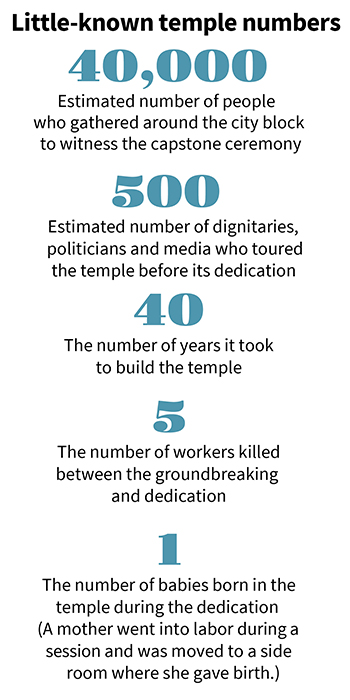
Graphic by Heather Tuttle, Deseret News.
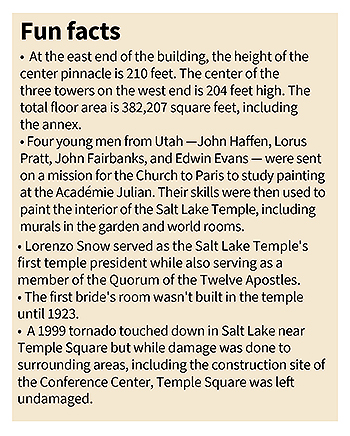
Graphic by Heather Tuttle, Deseret News.

A worker scales the scaffolding of the Salt Lake Temple during its renovation.
Photo courtesy of the Church History Library.
In 1847, long before ground for the temple was broken, Brigham Young put the faith of the Saints to the test by having them first build a wall.
“The very first efforts on that temple started with the wall that’s around it right now,” Olmstead said. Although much of it has been repaired or replaced, the wall, which was built primarily of adobe set on a foundation of red sandstone, remains around Temple Square today. Building the wall was a learning opportunity that taught the Saints many things, including how to move large stones from the mountains and transport them to the temple site. But it also afforded Brigham Young an opportunity to gauge the commitment of the Latter-day Saints to building another temple, Olmstead explained.
And while to many the wall may seem an unimportant part of the temple’s history, President Wilford Woodruff mentioned the wall in his dedication of the temple more than 40 years later, and even today the wall continues to serve an important purpose by preserving the quiet and contemplative space around the temple, acting as a symbol for leaving the outside world to move into a holier space, Olmstead said.
Hosanna handkerchiefs
One little-known fact about Church history is that the Hosanna shout—a key part of every temple dedication in living memory—was first introduced as it is now known at the capstone ceremony for the Salt Lake Temple, exactly one year prior to its official dedication, on April 6, 1892.
“Most saints draw a connection between the Hosanna shout that was given in Kirtland at the dedication and what we do today,” Olmstead explained. And while the two are fundamentally the same, one big difference was introduced at the Salt Lake Temple.
It was during the capstone ceremony that Lorenzo Snow first introduced the waving of the white handkerchief and instructed Saints as to the cadence of the shout.
“That moment is what is replicated in all the temple [dedications] today,” Olmstead said.
Fasting for the temple
In the last years of temple construction in the early 1890s, the Saints in Utah experienced a great deal of turmoil. A raid from the federal government and fear of losing temples and property after the implementation of the Edmunds Tucker Act were followed by the Church manifesto in 1890 as well as the dismantling of the “people’s party”—a political party of Latter-day Saints—to make way for the more widely accepted Democratic and Republican parties. With many changes, the Saints underwent a period of confusion and disunity as they were separated ideologically and politically in many ways.
“The Saints didn’t know how to deal with this[;] . . . they struggled mightily,” Olmstead said. The differences caused many contentions which were “top to bottom an issue for the whole Church.”
Such contentions caused concerns about whether the Saints were worthy to dedicate a temple—one meant to fulfill the prophecy of Isaiah—and whether the Lord would accept their offering, because of their sins against one another. As a response to these worries, a Churchwide fast was held prior to the dedication as the Saints sought forgiveness and apologized for the wrongs they had done to one another, Olmstead explained. As a result, themes of unity and forgiveness were a central focus in the dedicatory prayers of the temple beginning on April 6, 1893, marking the Lord’s acceptance of their sacrifices.
A life calling
For Joseph Henry Dean, a man who served as a carpenter for the temple working continually into the last months of construction prior to the dedication, the temple became the true center of his life and his life’s work.
As work on the temple drew to a close, many of the workers were slowly released from their commissions as their work finished. Dean, thinking he too would be let go, wrote in his journal nearly every day during the last year of the temple’s construction that he felt he would be the next one to be let go. But he never was, Olmstead said.
Dean was one of the few who was kept on to work on interior details after the dedication, like the stained-glass windows in the domed ceiling of the Holy of Holies. And later, when Dean found out about the possibility of a temple custodian position, a long-term caretaker for the temple, he wrote in his journal that such a position was the secret wish of his heart.
“So one day he is walking in the street, and he runs into Lorenzo Snow,” Olmstead said. “And Lorenzo Snow is the first temple president of Salt Lake, and he is a member of the Quorum of the Twelve Apostles. And he comes up to [Dean] in the street and essentially says, ‘I want you to know, if you so choose, we’re going to give you this position as custodian of the temple, and you can go on and spend your remaining days, nights, and life in the temple.’ ”
The offer was an answer to Dean’s prayers, and in his diary he attributed the blessing as a result of his willingness to donate more than a month’s worth of his salary to the temple in the final year of its construction. It had been a time when the Church was in great need of money, more so than for volunteers or laborers, and he noted that because of his decision, “the Lord has seen fit to bless me with this opportunity to spend the rest of my life in serving at the temple.”
Constant change
While many modern conveniences like steel framing, steam heating, electricity, and even elevators were developed and thus able to be implemented into the temple over the long 40-year period of its construction, improvements continually took place throughout the 20th century.
What most people don’t realize, Olmstead said, is that the stone temple that most people are familiar with was built as a hollow shell. As the walls were built higher and higher, large stones were eventually brought into the interior of the shell and hoisted up from the inside rather than the outside, as the foundational stones had been done, to minimize their movement along the towering walls.
“That meant that when it came time to work on the interior, there was a completely fresh slate,” Olmstead said.
Initially, the temple plans were modeled to fit the exact dimensions and floor plans of the Nauvoo temple, with a baptistry below ground and public assembly halls with offices on the two floors above. And although the temple’s architect, Truman Angell, had designed floors for the interior, his death during the 40 years of construction left the majority of the interior designs in the hands of engineer and newly appointed temple architect Joseph Don Carlos Young to construct.
By the time Young was left in charge, new revelations about how ordinances for the dead were meant to be carried out in the temple, as well as the construction of three other temples—St. George, Manti, and Logan—had taught the Saints more about the importance of certain types of spaces in the temple, and the plans for the interior were completely redesigned.
Additionally, by that time steel had been introduced to large buildings in New York and Boston and was similarly able to be incorporated for structural purposes in the temple. Updates to the annex areas and even the baptistry were made in the 1920s and ’30s, but it was mostly in the early 1960s that the temple was closed for some larger renovations, including a complete upgrade of the electrical, mechanical, and plumbing systems and the addition of 10 new sealing rooms.
But the way people think of the temple today mostly comes from those late-20th-century updates, Utt said. “The ways that we use the temple and enter the temple are not the ways that it’s historically been,” she said. “They’re largely a product of the 1960s. Prior to that, if you were visiting the temple for a wedding, you would use the east doors, the main historic doors of the temple, and wedding parties would gather behind the sealing rooms just inside the walls. That’s where all those events took place. And Church leadership, going to meetings on the upper floors of the temple, would enter through the west doors and go up the elevator.”
It is interesting, she noted, to look at the ways people enter and use the temple and see how they have shifted so dramatically over such a relatively short time.
From adobe to granite

Men quarry stone for the construction of the Salt Lake Temple. Photo by Charles W. Carter, courtesy of the Church History Library.
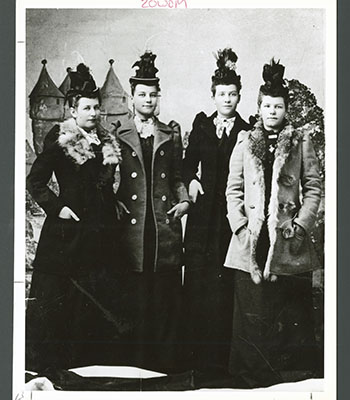
Carrie Thorsen, Lucy Allen, Emma Neilsen, and Charlotte Allen. Women's support was key to the construction of the sacred edifice. Photo courtesy of the Church History Library.
During the general conference sessions of October 1852, members were invited to discuss the materials that should be used in the building of the temple. But there was no discussion of granite, Olmstead said. “The one thing the Saints agreed on was to build the temple of the best materials afforded by the mountains of North America.”
But Brigham Young believed that sandstone—a mix of mud and straw—would turn to stone over time, Olmstead said, explaining that despite other options proposed at the conference, Young wanted to build the temple walls from adobe with a thin exterior veneer of stone.
And while they eventually switched their plans to use granite—the “how” and “why” behind the switch are not entirely understood or recorded—it is because of the initial plans to use adobe that the temple walls were built so thick, Olmstead explained.
Adobe walls require a different ratio of width to height to sustain the weight of tall structures on the lower layers, Olmstead said. So when the temple was designed with adobe in mind, they had to make the walls very thick, nearly eight feet. And it appears that although they switched materials, they didn’t alter the initial designs, and so the temple was built with granite walls much thicker than perhaps otherwise would have been used.
In 1855, the Saints in the Salt Lake Valley began pulling granite from the Wasatch Mountains, but contrary to common belief, there was no quarry for the temple stones. As Olmstead explained it, they began first in Big Cottonwood Canyon, pulling stones that were sloughed off the sides of the mountains. They then moved farther south to Little Cottonwood Canyon, where the quality of stone was better suited for the temple.
“They were taking these big stones that were already fallen from the side of the mountains and then cut them down,” Olmstead said, noting that they never tunneled or built a real quarry. “They were just pulling them out from the mouth of the canyon, and as they ran out, they moved further up the canyon.”
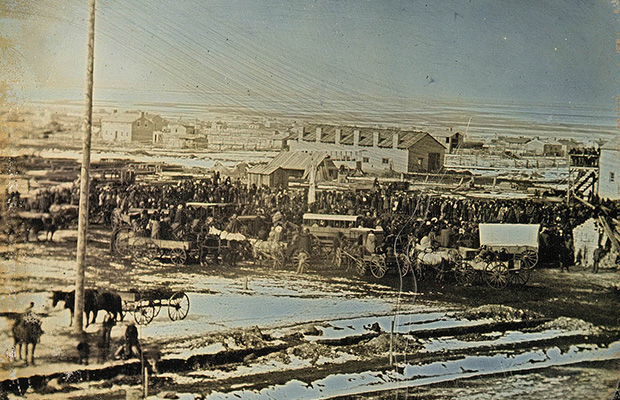
Groundbreaking of the Salt Lake Temple, February 14, 1853. Photo courtesy of the Church History Library.

Photograph of the foundation of the Salt Lake Temple, taken about 1872. Photo by William C. Carter.
Photo courtesy of the Church History Library.

Photograph of the uncompleted walls of the Salt Lake Temple, taken about 1885. Photo courtesy of the Church History Library.

Scaffolding surrounds the Salt Lake Temple during the Saturday morning session of conference. Photo courtesy of the Church History Library.
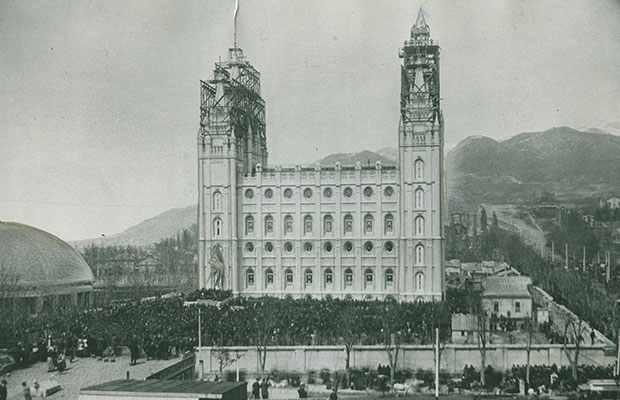
The Salt Lake Temple nearing completion, with a large crowd assembled for the capstone-laying ceremony. The temple was dedicated in April 1893. Photo courtesy of the Church History Library.

The Salt Lake Temple after its dedication in April 1893. Photo courtesy of the Church History Library.

A March 30, 1963, picture of the construction site, showing the sandstone subfoundation to the granite foundations under the main entrance to the Salt Lake Temple. Photo by Ralph T. Clark, Deseret News archives.

The massive foundation of the Salt Lake Temple is exposed, September 8, 1962. Linden W. Millgate, engineer, inspects footings. Photo courtesy of Deseret News archives.

The depth and strength of the Salt Lake Temple foundation, 30 feet deep, is exposed by excavators on March 30, 1963. Photo by Ralph T. Clark, Deseret News archives.

Wilford Hansen checks the water being used in cutting a huge piece of granite for temple projects on January 28, 1963. Saw is at lower right. Photo courtesy of Deseret News archives.
